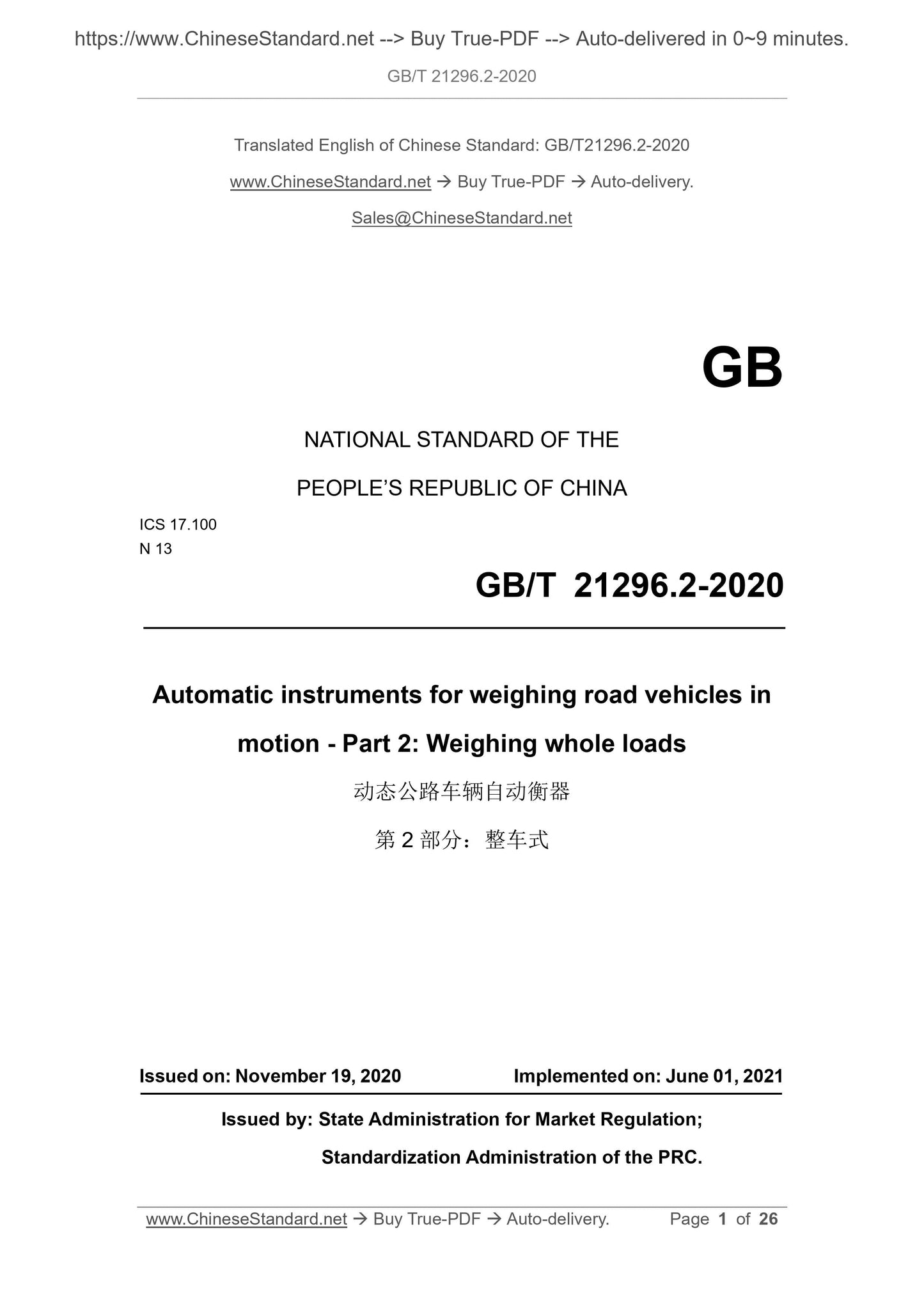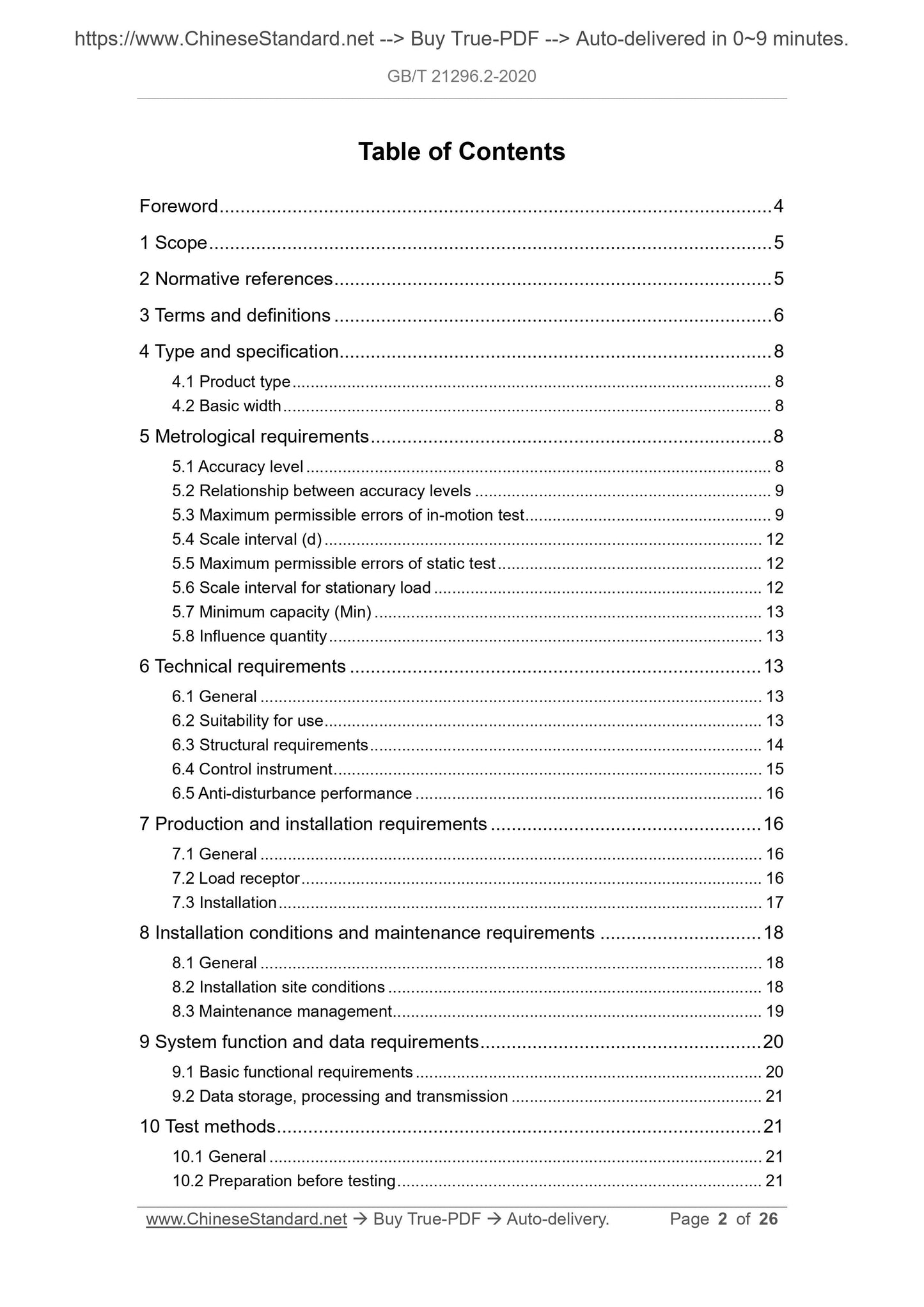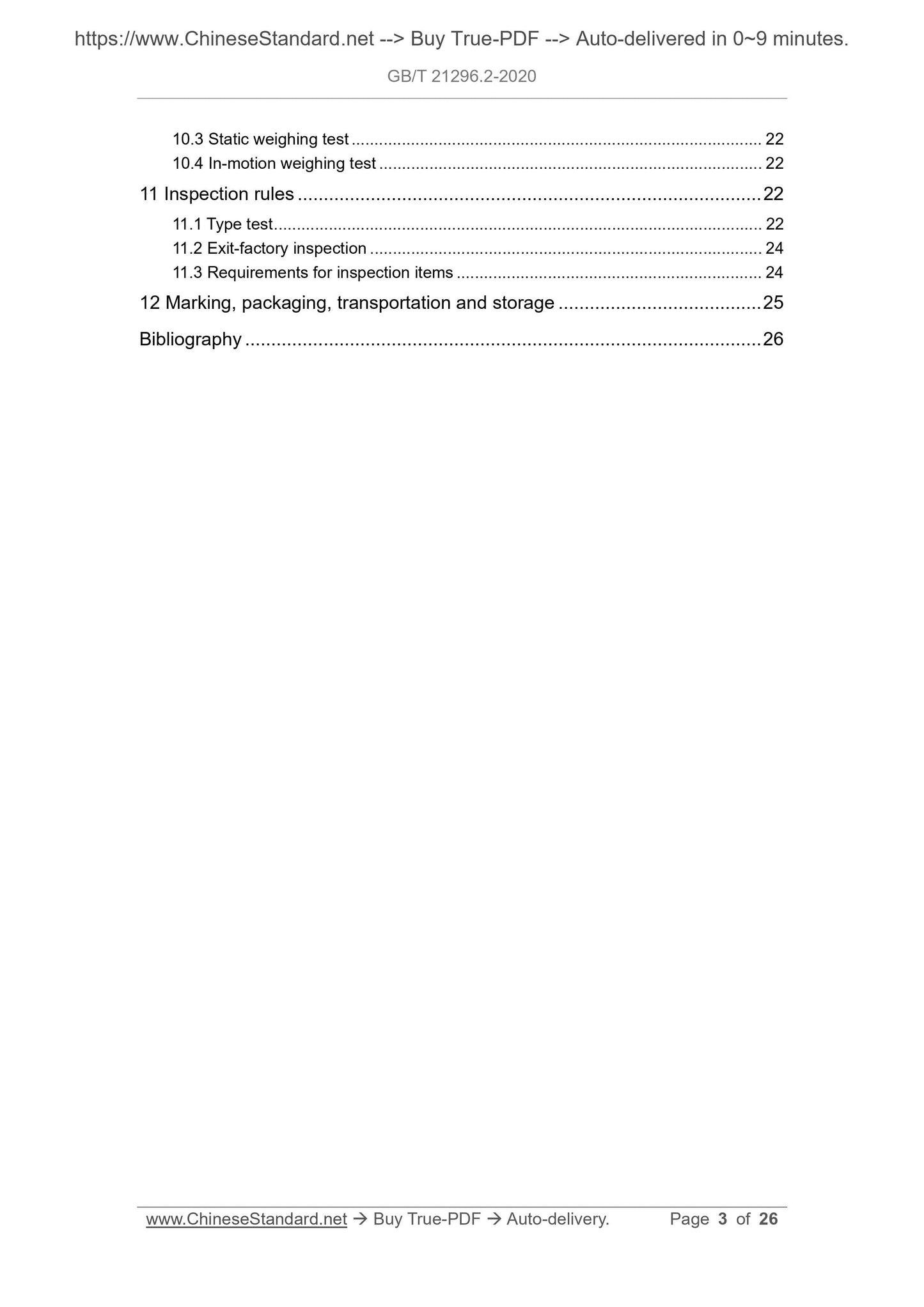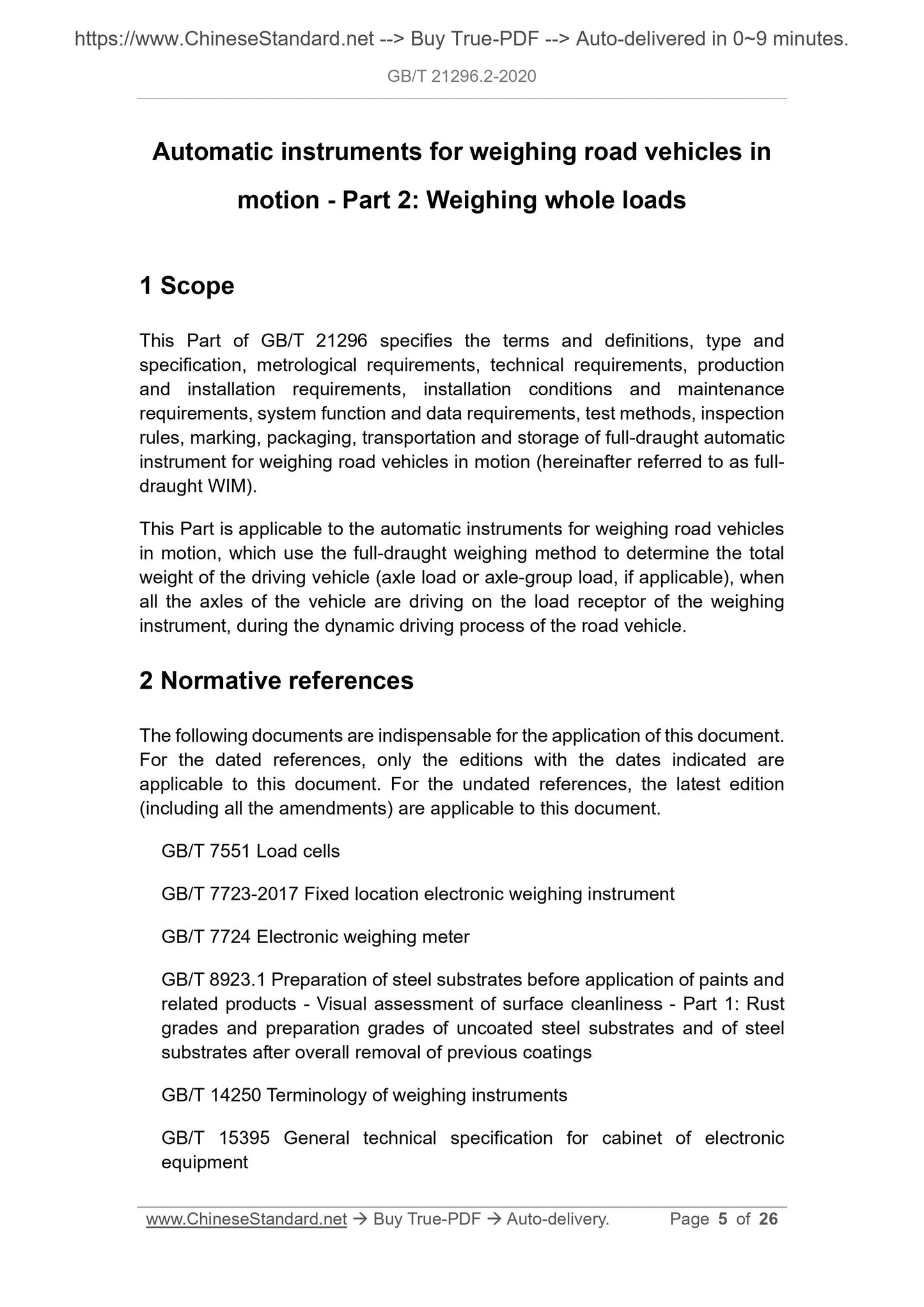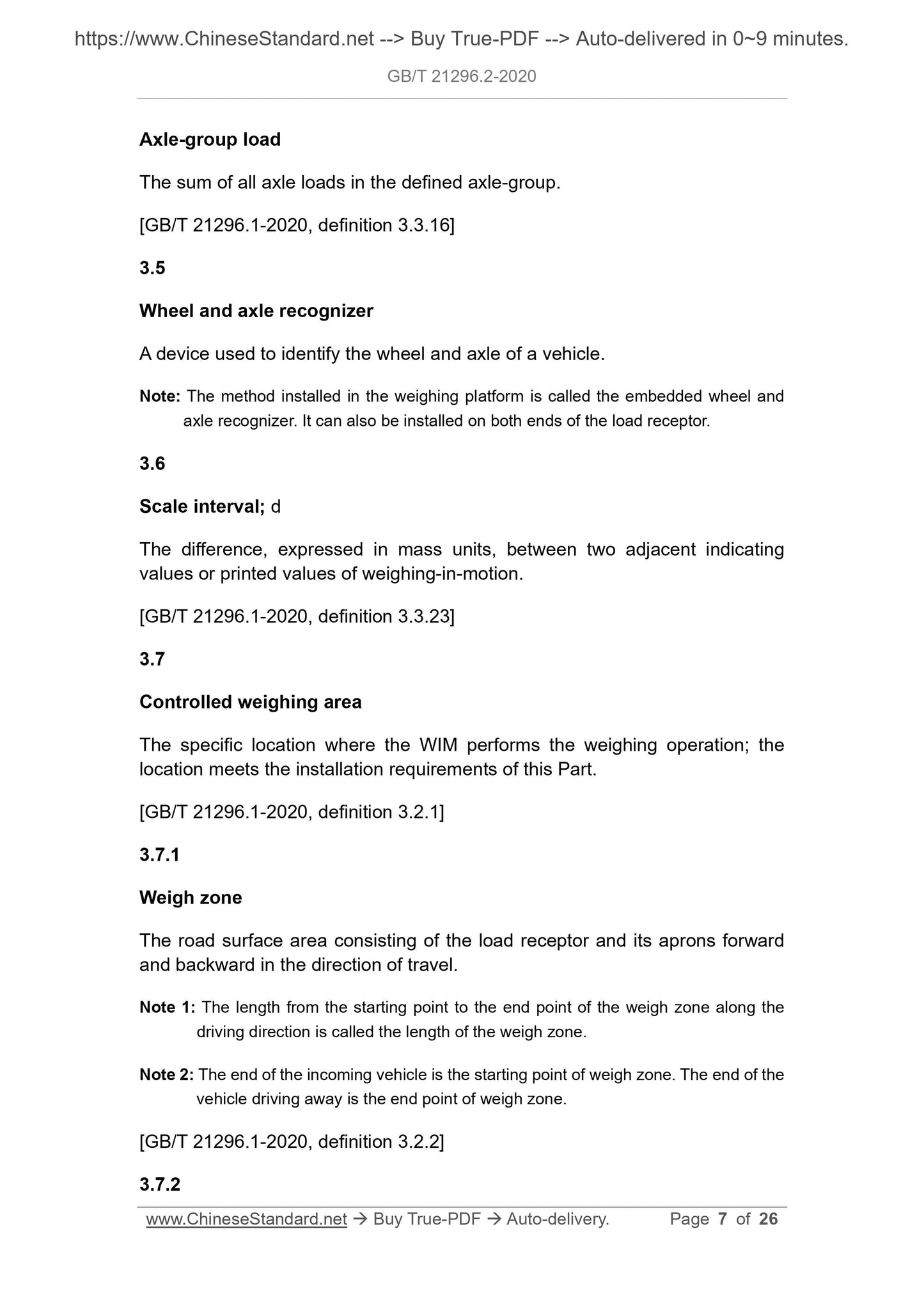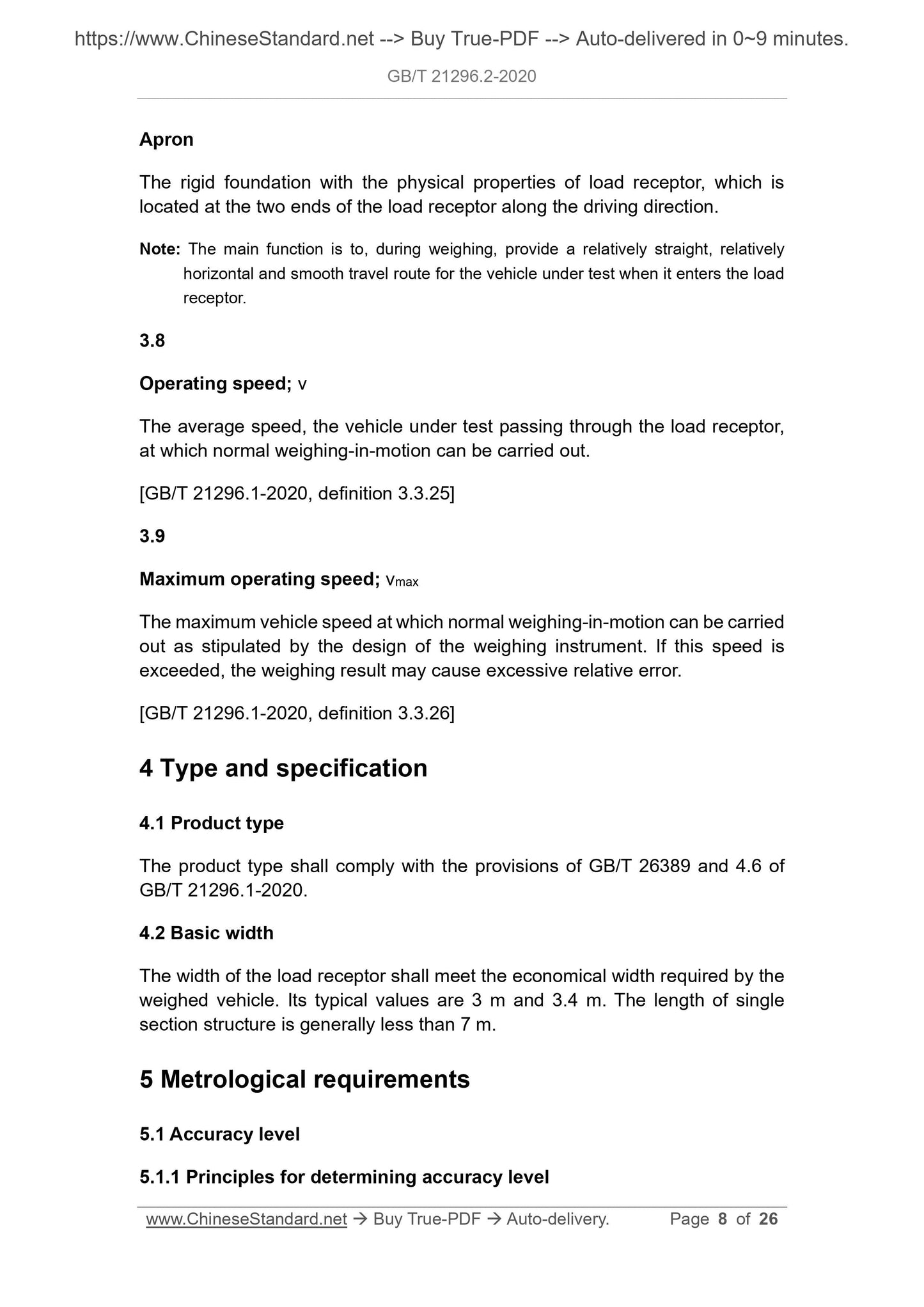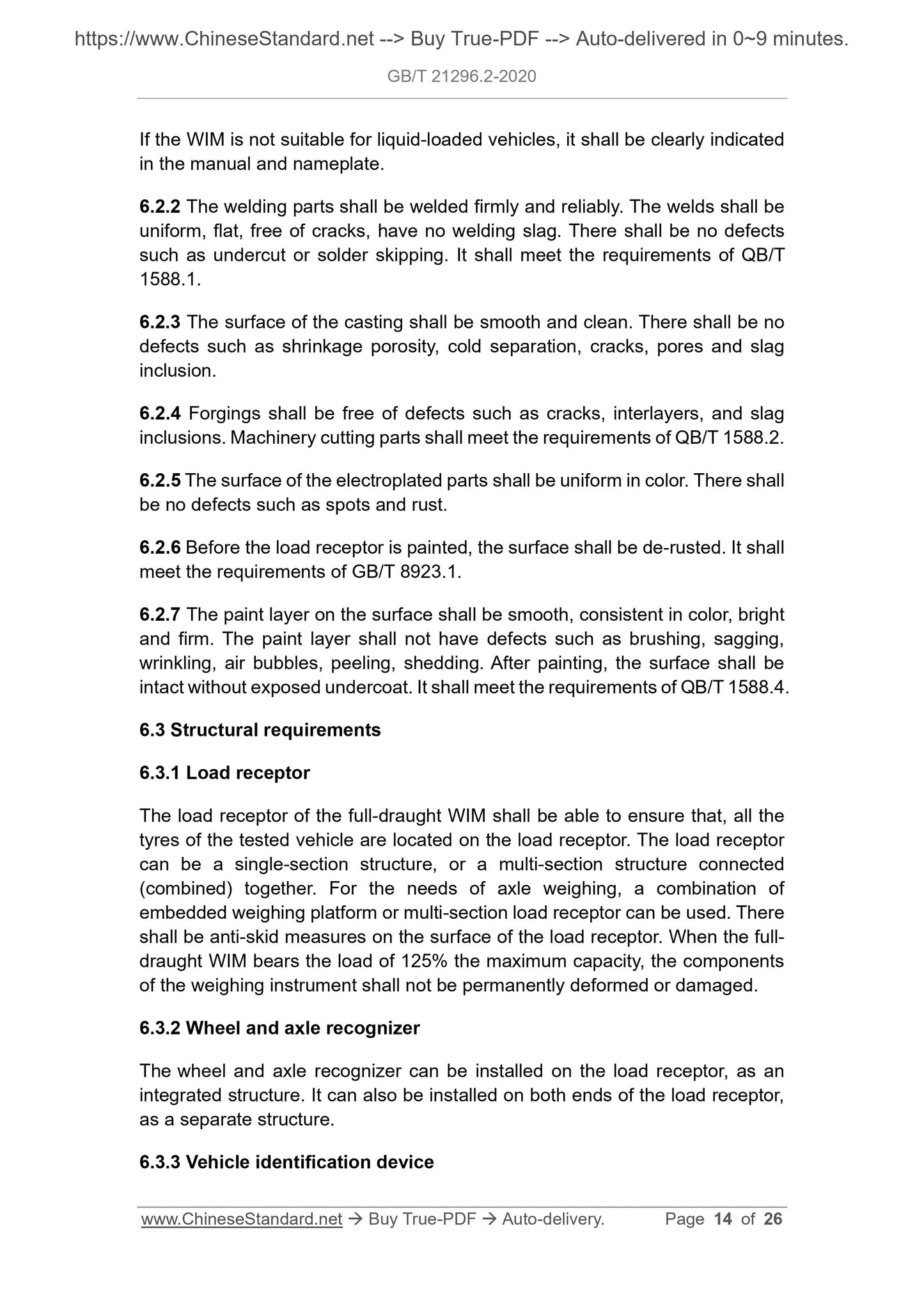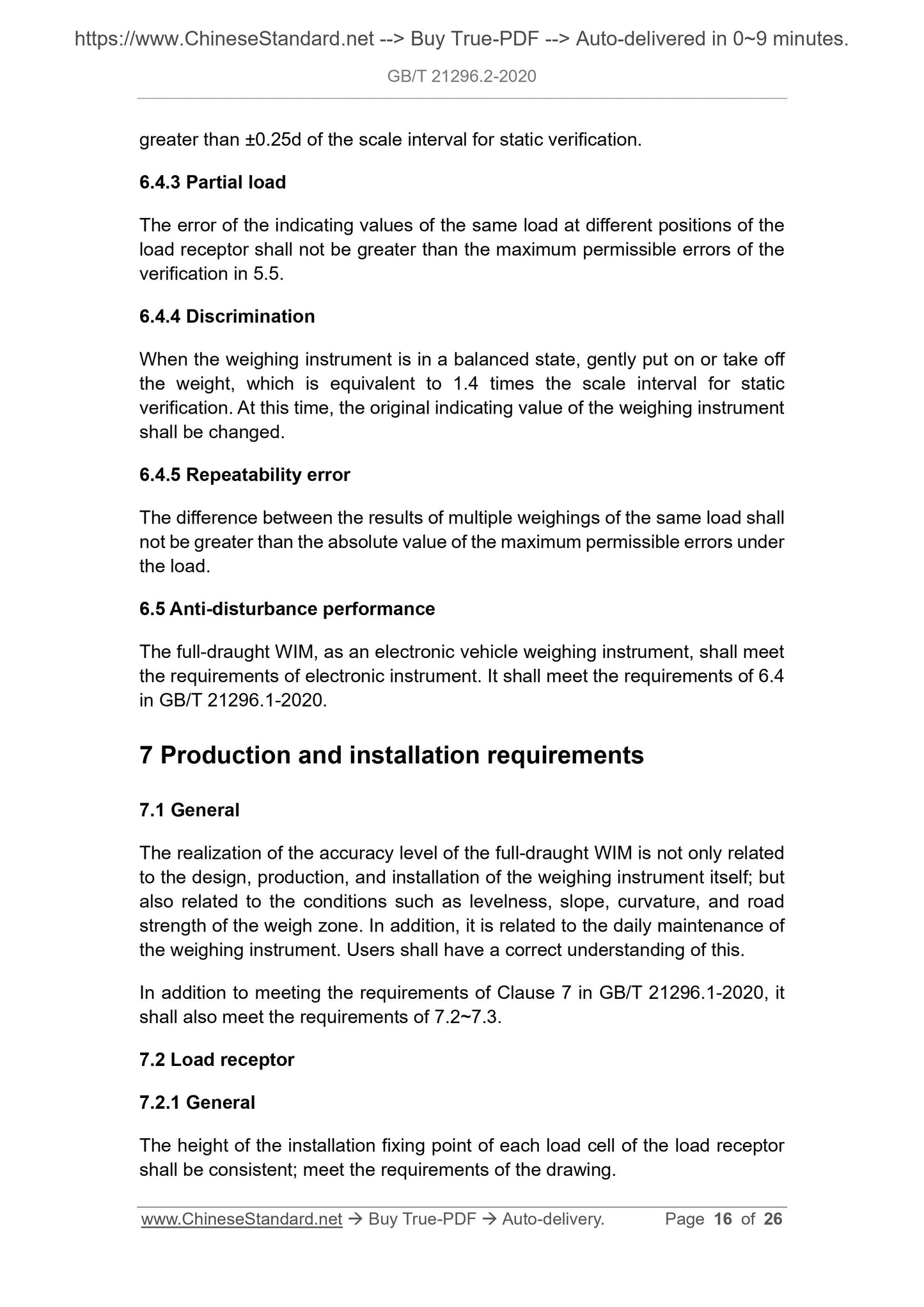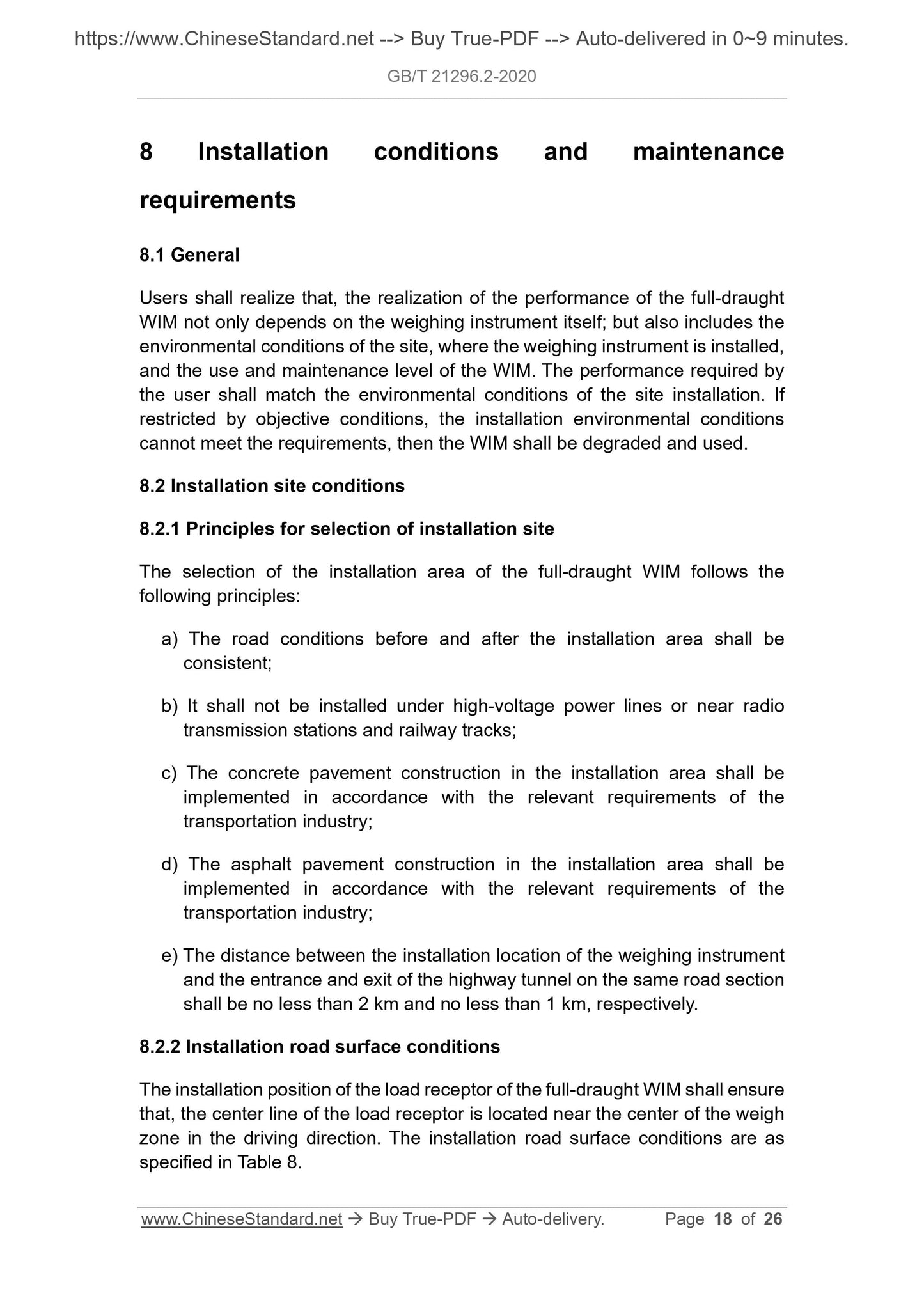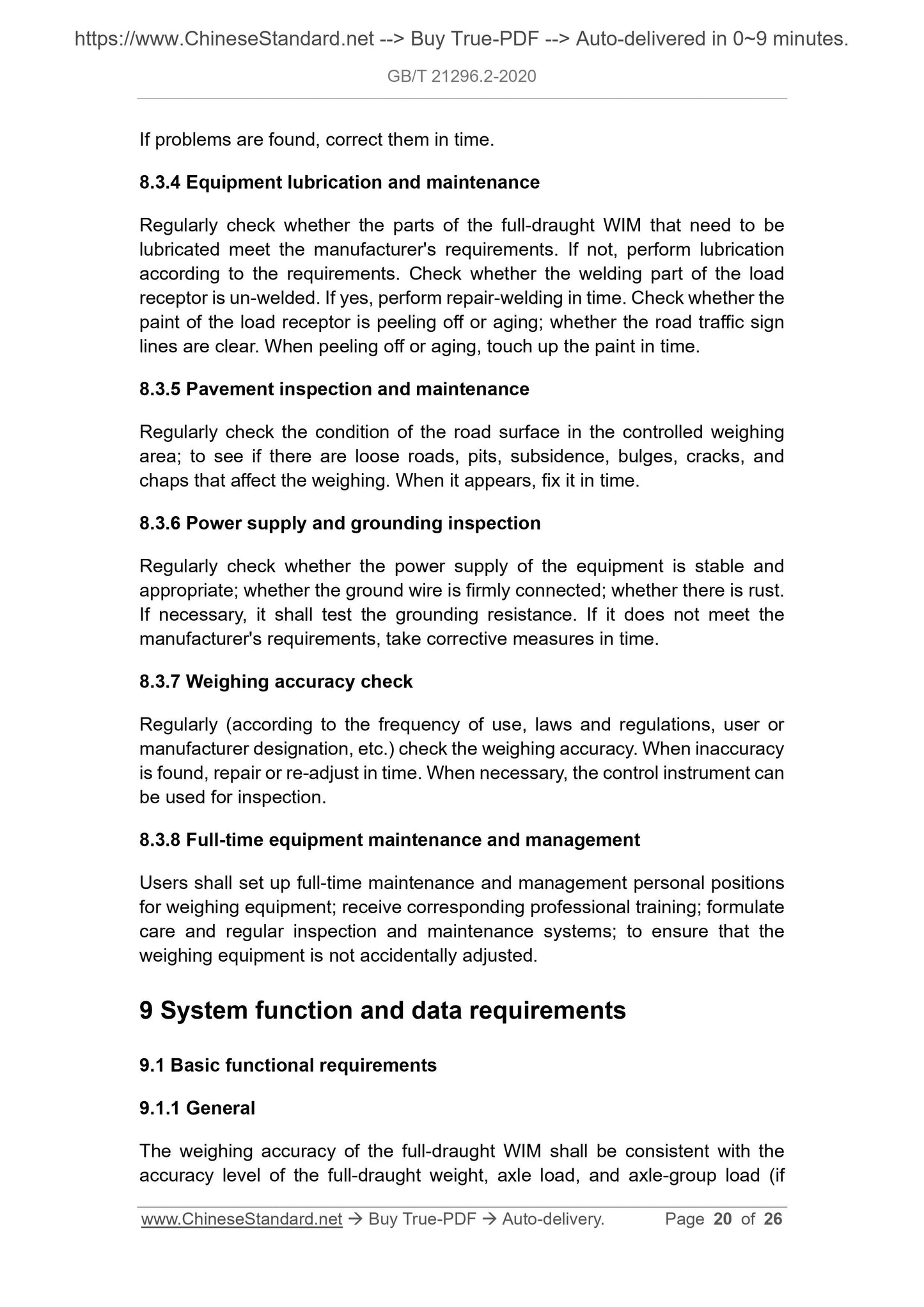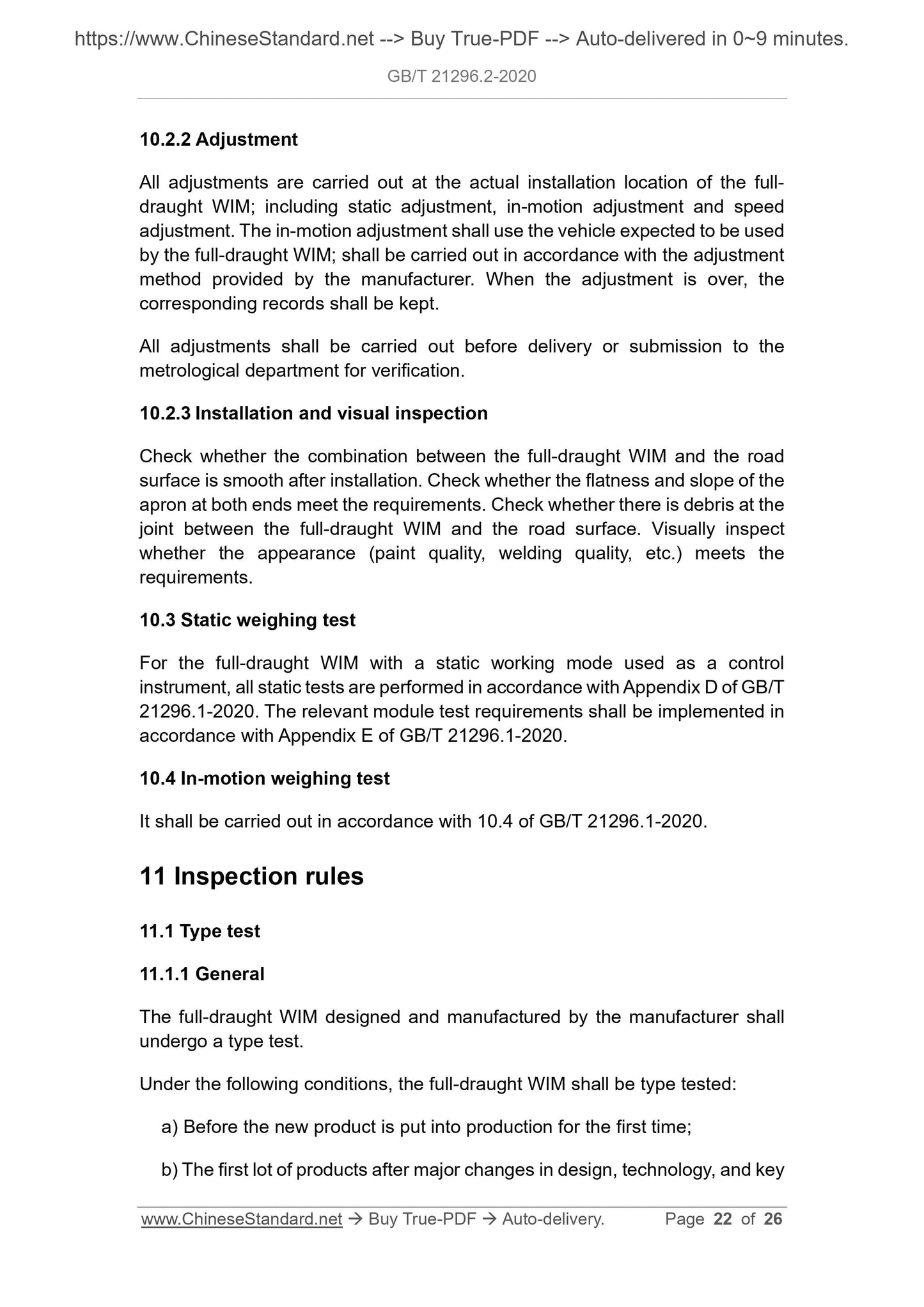1
/
of
11
PayPal, credit cards. Download editable-PDF and invoice in 1 second!
GB/T 21296.2-2020 English PDF (GBT21296.2-2020)
GB/T 21296.2-2020 English PDF (GBT21296.2-2020)
Regular price
$245.00 USD
Regular price
Sale price
$245.00 USD
Unit price
/
per
Shipping calculated at checkout.
Couldn't load pickup availability
Delivery: 3 seconds. Download true-PDF + Invoice.
Get QUOTATION in 1-minute: Click GB/T 21296.2-2020
Historical versions: GB/T 21296.2-2020
Preview True-PDF (Reload/Scroll if blank)
GB/T 21296.2-2020: Automatic instruments for weighing road vehicles in motion -- Part 2: Weighing whole loads
GB/T 21296.2-2020
GB
NATIONAL STANDARD OF THE
PEOPLE’S REPUBLIC OF CHINA
ICS 17.100
N 13
Automatic instruments for weighing road vehicles in
motion - Part 2: Weighing whole loads
ISSUED ON: NOVEMBER 19, 2020
IMPLEMENTED ON: JUNE 01, 2021
Issued by: State Administration for Market Regulation;
Standardization Administration of the PRC.
Table of Contents
Foreword ... 4
1 Scope ... 5
2 Normative references ... 5
3 Terms and definitions ... 6
4 Type and specification... 8
4.1 Product type ... 8
4.2 Basic width ... 8
5 Metrological requirements ... 8
5.1 Accuracy level ... 8
5.2 Relationship between accuracy levels ... 9
5.3 Maximum permissible errors of in-motion test ... 9
5.4 Scale interval (d) ... 12
5.5 Maximum permissible errors of static test ... 12
5.6 Scale interval for stationary load ... 12
5.7 Minimum capacity (Min) ... 13
5.8 Influence quantity ... 13
6 Technical requirements ... 13
6.1 General ... 13
6.2 Suitability for use ... 13
6.3 Structural requirements ... 14
6.4 Control instrument ... 15
6.5 Anti-disturbance performance ... 16
7 Production and installation requirements ... 16
7.1 General ... 16
7.2 Load receptor ... 16
7.3 Installation ... 17
8 Installation conditions and maintenance requirements ... 18
8.1 General ... 18
8.2 Installation site conditions ... 18
8.3 Maintenance management ... 19
9 System function and data requirements ... 20
9.1 Basic functional requirements ... 20
9.2 Data storage, processing and transmission ... 21
10 Test methods ... 21
10.1 General ... 21
10.2 Preparation before testing ... 21
10.3 Static weighing test ... 22
10.4 In-motion weighing test ... 22
11 Inspection rules ... 22
11.1 Type test ... 22
11.2 Exit-factory inspection ... 24
11.3 Requirements for inspection items ... 24
12 Marking, packaging, transportation and storage ... 25
Bibliography ... 26
Automatic instruments for weighing road vehicles in
motion - Part 2: Weighing whole loads
1 Scope
This Part of GB/T 21296 specifies the terms and definitions, type and
specification, metrological requirements, technical requirements, production
and installation requirements, installation conditions and maintenance
requirements, system function and data requirements, test methods, inspection
rules, marking, packaging, transportation and storage of full-draught automatic
instrument for weighing road vehicles in motion (hereinafter referred to as full-
draught WIM).
This Part is applicable to the automatic instruments for weighing road vehicles
in motion, which use the full-draught weighing method to determine the total
weight of the driving vehicle (axle load or axle-group load, if applicable), when
all the axles of the vehicle are driving on the load receptor of the weighing
instrument, during the dynamic driving process of the road vehicle.
2 Normative references
The following documents are indispensable for the application of this document.
For the dated references, only the editions with the dates indicated are
applicable to this document. For the undated references, the latest edition
(including all the amendments) are applicable to this document.
GB/T 7551 Load cells
GB/T 7723-2017 Fixed location electronic weighing instrument
GB/T 7724 Electronic weighing meter
GB/T 8923.1 Preparation of steel substrates before application of paints and
related products - Visual assessment of surface cleanliness - Part 1: Rust
grades and preparation grades of uncoated steel substrates and of steel
substrates after overall removal of previous coatings
GB/T 14250 Terminology of weighing instruments
GB/T 15395 General technical specification for cabinet of electronic
equipment
Axle-group load
The sum of all axle loads in the defined axle-group.
[GB/T 21296.1-2020, definition 3.3.16]
3.5
Wheel and axle recognizer
A device used to identify the wheel and axle of a vehicle.
Note: The method installed in the weighing platform is called the embedded wheel and
axle recognizer. It can also be installed on both ends of the load receptor.
3.6
Scale interval; d
The difference, expressed in mass units, between two adjacent indicating
values or printed values of weighing-in-motion.
[GB/T 21296.1-2020, definition 3.3.23]
3.7
Controlled weighing area
The specific location where the WIM performs the weighing operation; the
location meets the installation requirements of this Part.
[GB/T 21296.1-2020, definition 3.2.1]
3.7.1
Weigh zone
The road surface area consisting of the load receptor and its aprons forward
and backward in the direction of travel.
Note 1: The length from the starting point to the end point of the weigh zone along the
driving direction is called the length of the weigh zone.
Note 2: The end of the incoming vehicle is the starting point of weigh zone. The end of the
vehicle driving away is the end point of weigh zone.
[GB/T 21296.1-2020, definition 3.2.2]
3.7.2
Apron
The rigid foundation with the physical properties of load receptor, which is
located at the two ends of the load receptor along the driving direction.
Note: The main function is to, during weighing, provide a relatively straight, relatively
horizontal and smooth travel route for the vehicle under test when it enters the load
receptor.
3.8
Operating speed; v
The average speed, the vehicle under test passing through the load receptor,
at which normal weighing-in-motion can be carried out.
[GB/T 21296.1-2020, definition 3.3.25]
3.9
Maximum operating speed; vmax
The maximum vehicle speed at which normal weighing-in-motion can be carried
out as stipulated by the design of the weighing instrument. If this speed is
exceeded, the weighing result may cause excessive relative error.
[GB/T 21296.1-2020, definition 3.3.26]
4 Type and specification
4.1 Product type
The product type shall comply with the provisions of GB/T 26389 and 4.6 of
GB/T 21296.1-2020.
4.2 Basic width
The width of the load receptor shall meet the economical width required by the
weighed vehicle. Its typical values are 3 m and 3.4 m. The length of single
section structure is generally less than 7 m.
5 Metrological requirements
5.1 Accuracy level
5.1.1 Principles for determining accuracy level
If the WIM is not suitable for liquid-loaded vehicles, it shall be clearly indicated
in the manual and nameplate.
6.2.2 The welding parts shall be welded firmly and reliably. The welds shall be
uniform, flat, free of cracks, have no welding slag. There shall be no defects
such as undercut or solder skipping. It shall meet the requirements of QB/T
1588.1.
6.2.3 The surface of the casting shall be smooth and clean. There shall be no
defects such as shrinkage porosity, cold separation, cracks, pores and slag
inclusion.
6.2.4 Forgings shall be free of defects such as cracks, interlayers, and slag
inclusions. Machinery cutting parts shall meet the requirements of QB/T 1588.2.
6.2.5 The surface of the electroplated parts shall be uniform in color. There shall
be no defects such as spots and rust.
6.2.6 Before the load receptor is painted, the surface shall be de-rusted. It shall
meet the requirements of GB/T 8923.1.
6.2.7 The paint layer on the surface shall be smooth, consistent in color, bright
and firm. The paint layer shall not have def...
Get QUOTATION in 1-minute: Click GB/T 21296.2-2020
Historical versions: GB/T 21296.2-2020
Preview True-PDF (Reload/Scroll if blank)
GB/T 21296.2-2020: Automatic instruments for weighing road vehicles in motion -- Part 2: Weighing whole loads
GB/T 21296.2-2020
GB
NATIONAL STANDARD OF THE
PEOPLE’S REPUBLIC OF CHINA
ICS 17.100
N 13
Automatic instruments for weighing road vehicles in
motion - Part 2: Weighing whole loads
ISSUED ON: NOVEMBER 19, 2020
IMPLEMENTED ON: JUNE 01, 2021
Issued by: State Administration for Market Regulation;
Standardization Administration of the PRC.
Table of Contents
Foreword ... 4
1 Scope ... 5
2 Normative references ... 5
3 Terms and definitions ... 6
4 Type and specification... 8
4.1 Product type ... 8
4.2 Basic width ... 8
5 Metrological requirements ... 8
5.1 Accuracy level ... 8
5.2 Relationship between accuracy levels ... 9
5.3 Maximum permissible errors of in-motion test ... 9
5.4 Scale interval (d) ... 12
5.5 Maximum permissible errors of static test ... 12
5.6 Scale interval for stationary load ... 12
5.7 Minimum capacity (Min) ... 13
5.8 Influence quantity ... 13
6 Technical requirements ... 13
6.1 General ... 13
6.2 Suitability for use ... 13
6.3 Structural requirements ... 14
6.4 Control instrument ... 15
6.5 Anti-disturbance performance ... 16
7 Production and installation requirements ... 16
7.1 General ... 16
7.2 Load receptor ... 16
7.3 Installation ... 17
8 Installation conditions and maintenance requirements ... 18
8.1 General ... 18
8.2 Installation site conditions ... 18
8.3 Maintenance management ... 19
9 System function and data requirements ... 20
9.1 Basic functional requirements ... 20
9.2 Data storage, processing and transmission ... 21
10 Test methods ... 21
10.1 General ... 21
10.2 Preparation before testing ... 21
10.3 Static weighing test ... 22
10.4 In-motion weighing test ... 22
11 Inspection rules ... 22
11.1 Type test ... 22
11.2 Exit-factory inspection ... 24
11.3 Requirements for inspection items ... 24
12 Marking, packaging, transportation and storage ... 25
Bibliography ... 26
Automatic instruments for weighing road vehicles in
motion - Part 2: Weighing whole loads
1 Scope
This Part of GB/T 21296 specifies the terms and definitions, type and
specification, metrological requirements, technical requirements, production
and installation requirements, installation conditions and maintenance
requirements, system function and data requirements, test methods, inspection
rules, marking, packaging, transportation and storage of full-draught automatic
instrument for weighing road vehicles in motion (hereinafter referred to as full-
draught WIM).
This Part is applicable to the automatic instruments for weighing road vehicles
in motion, which use the full-draught weighing method to determine the total
weight of the driving vehicle (axle load or axle-group load, if applicable), when
all the axles of the vehicle are driving on the load receptor of the weighing
instrument, during the dynamic driving process of the road vehicle.
2 Normative references
The following documents are indispensable for the application of this document.
For the dated references, only the editions with the dates indicated are
applicable to this document. For the undated references, the latest edition
(including all the amendments) are applicable to this document.
GB/T 7551 Load cells
GB/T 7723-2017 Fixed location electronic weighing instrument
GB/T 7724 Electronic weighing meter
GB/T 8923.1 Preparation of steel substrates before application of paints and
related products - Visual assessment of surface cleanliness - Part 1: Rust
grades and preparation grades of uncoated steel substrates and of steel
substrates after overall removal of previous coatings
GB/T 14250 Terminology of weighing instruments
GB/T 15395 General technical specification for cabinet of electronic
equipment
Axle-group load
The sum of all axle loads in the defined axle-group.
[GB/T 21296.1-2020, definition 3.3.16]
3.5
Wheel and axle recognizer
A device used to identify the wheel and axle of a vehicle.
Note: The method installed in the weighing platform is called the embedded wheel and
axle recognizer. It can also be installed on both ends of the load receptor.
3.6
Scale interval; d
The difference, expressed in mass units, between two adjacent indicating
values or printed values of weighing-in-motion.
[GB/T 21296.1-2020, definition 3.3.23]
3.7
Controlled weighing area
The specific location where the WIM performs the weighing operation; the
location meets the installation requirements of this Part.
[GB/T 21296.1-2020, definition 3.2.1]
3.7.1
Weigh zone
The road surface area consisting of the load receptor and its aprons forward
and backward in the direction of travel.
Note 1: The length from the starting point to the end point of the weigh zone along the
driving direction is called the length of the weigh zone.
Note 2: The end of the incoming vehicle is the starting point of weigh zone. The end of the
vehicle driving away is the end point of weigh zone.
[GB/T 21296.1-2020, definition 3.2.2]
3.7.2
Apron
The rigid foundation with the physical properties of load receptor, which is
located at the two ends of the load receptor along the driving direction.
Note: The main function is to, during weighing, provide a relatively straight, relatively
horizontal and smooth travel route for the vehicle under test when it enters the load
receptor.
3.8
Operating speed; v
The average speed, the vehicle under test passing through the load receptor,
at which normal weighing-in-motion can be carried out.
[GB/T 21296.1-2020, definition 3.3.25]
3.9
Maximum operating speed; vmax
The maximum vehicle speed at which normal weighing-in-motion can be carried
out as stipulated by the design of the weighing instrument. If this speed is
exceeded, the weighing result may cause excessive relative error.
[GB/T 21296.1-2020, definition 3.3.26]
4 Type and specification
4.1 Product type
The product type shall comply with the provisions of GB/T 26389 and 4.6 of
GB/T 21296.1-2020.
4.2 Basic width
The width of the load receptor shall meet the economical width required by the
weighed vehicle. Its typical values are 3 m and 3.4 m. The length of single
section structure is generally less than 7 m.
5 Metrological requirements
5.1 Accuracy level
5.1.1 Principles for determining accuracy level
If the WIM is not suitable for liquid-loaded vehicles, it shall be clearly indicated
in the manual and nameplate.
6.2.2 The welding parts shall be welded firmly and reliably. The welds shall be
uniform, flat, free of cracks, have no welding slag. There shall be no defects
such as undercut or solder skipping. It shall meet the requirements of QB/T
1588.1.
6.2.3 The surface of the casting shall be smooth and clean. There shall be no
defects such as shrinkage porosity, cold separation, cracks, pores and slag
inclusion.
6.2.4 Forgings shall be free of defects such as cracks, interlayers, and slag
inclusions. Machinery cutting parts shall meet the requirements of QB/T 1588.2.
6.2.5 The surface of the electroplated parts shall be uniform in color. There shall
be no defects such as spots and rust.
6.2.6 Before the load receptor is painted, the surface shall be de-rusted. It shall
meet the requirements of GB/T 8923.1.
6.2.7 The paint layer on the surface shall be smooth, consistent in color, bright
and firm. The paint layer shall not have def...
Share
